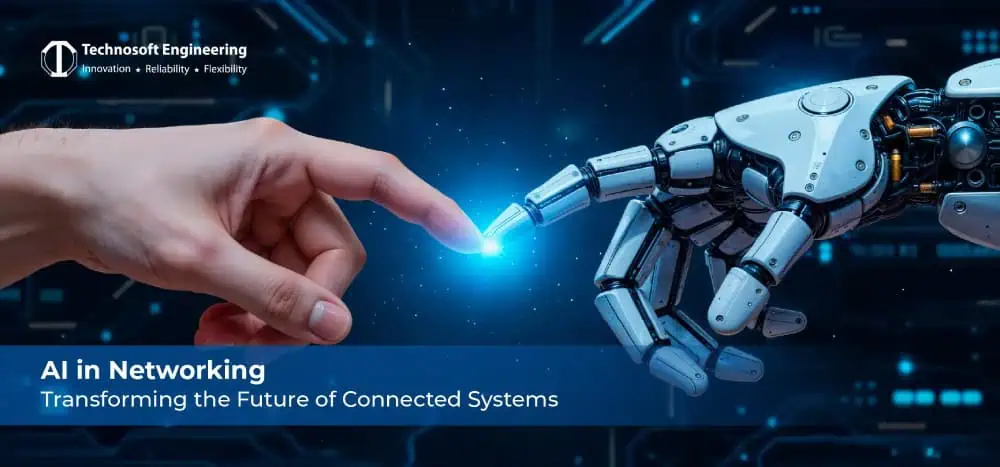
The networking world is developing at an astounding rate. Building on infrastructures driven by cloud computing, an increasingly distributed and complex network with a hybrid workforce, the path of network growth in the future has become more convoluted than ever. Securing and monitoring such huge digital environments cannot be done manually. That is where AI in networking comes in to help IT teams design, track, and optimise the networks with more intelligence and efficiency.
Artificial intelligence (AI) combined with machine learning (ML) and advanced analytics enables enterprises to create more secure, self-healing, and adaptive networks that meet the challenges of future AI-driven networks. In networking, what is AI capable of? What are the benefits, and how are industries being reshaped by new AI applications?
Benefits of AI and ML in Networking
Artificial Intelligence refers to the ability of a computer to display human capabilities in decision-making, learning, and problem-solving. AI applies network knowledge in an automated fashion, enabling the network itself to leverage data and algorithms to continuously monitor traffic, detect abnormalities, troubleshoot scenarios, and make predictions about failures.
It would be necessary to distinguish between the concepts of AI and networking:
- AI includes the intelligence layer to analyze the enormous network information.
- Machine Learning is a subset of AI where systems can learn using historical network data and continually improve without being reprogrammed.
Taken together, they are the cornerstones of AI and ML in networking, delivering more intelligent insights and more resilient functions.
How AI Transforms Networking?
Traditional networks are manpower driven and reactionary. In comparison, AI-based networks utilize analytics and automation to optimize performance proactively. Here are the ways in which the AI is transforming network management:
Custom Baselines for Alerts – AI can be used to learn what normal behavior looks like in a specific network, thereby eliminating false positive alerts and only alerting IT teams when it is truly necessary.
Telemetry and Analytics – Telemetry data is ingested and analyzed using AI/ML engines to identify, track, and query anomalies in usage information, as well as provide guidance on any remediation needed.
Continuous Learning – The more current data an AI system is provided with, the better it will get at predicting problems.
Crowdsourced Intelligence -There are also AI solutions that analyze data on thousands of anonymous networks and apply global knowledge to specific organizations.
The result? A smarter, highly resilient network that can change in real time according to the demands.
Major uses for artificial intelligence in computer networks
The range of deployment of artificial intelligence in computer network use is cross-industry and cross-deployment. Among the most influential, there can be included:
1. Wi-Fi Optimization AI/ML
As we transition to more hybrid work environments and utilize IoT devices, high-quality Wi-Fi is essential. Using AI and ML, problems such as congestion, interference, and load patterns can be identified during or ahead of time, helping to avoid disruptions to the user experience before they occur.
2. End-Pause
IoT devices are usually not visible or secure. Using AI, it can classify unknown devices, track their activities, and alert when they exhibit unusual behavior. This enhances protection and endpoint management of enterprise networks.
3. Automated Policy Management
Sruti traffic is analyzed, identifying the granular security policies through ML. This enables the implementation of the zero-trust concept more effectively, allowing the security of any interaction within the network to be restricted to only trusted employees.
4. Predictive Analytics
AI is used to analyze historical data to predict potential outages, capacity issues, or performance declines. This predictive functionality ensures that a network is not reactive in nature.
5. Machine Reasoning for Compliance
Machine Reasoning (MR), another branch of AI, assists IT teams in verifying software compliance across devices, pinpointing vulnerabilities, and giving remedies. MR, working with insights from ML, drives deeper intelligence about the network.
AI Network Management and Automation
Network automation is a core application of AI in networking. With the use of AI and ML models, an organization can:
- Automatically deploy and configure network devices
- Identify and classify endpoints without any human intervention
- Seamlessly integrate zero-trust security frameworks
- Constantly benchmark health against peers in the industry
Eventually, these networks will mature into fully self-optimizing and self-healing systems, drastically reducing downtime and the need for human intervention.
Future of Machine Learning and Networking
Machine learning and networking share parallel pathways in building predictive, adaptive, and secure digital infrastructures. The function of machine learning is to analyze network telemetry for:
- Detecting anomalies and filtering out noise
- Making recommendations towards performance enhancement
- Adjusting security policies in real-time based on threat intelligence.
With the rise of 5G, IoT, and edge computing technologies, machine learning will be necessary for managing highly distributed and data-intensive networks.
Why Partner with AI and ML Services?
The benefits are promising, but implementing AI into enterprise networks will require a well-defined strategy, suitable tools, and specialized expertise. And this is where specialized AI and ML services come in. Since the development of large-scale models and their integration with current CRMs, ERPs, or cloud services, professional partners like Technosoft Engineering will assist organizations in simplifying the process.
The AI and ML-based solutions of Technosoft are specifically created to:
- Augment enterprise security and compliance
- Improve network visibility and reliability
- Disruption to large-scale IoT and cloud connectivity
- Bringing operational cost savings through automation
Such solutions will enable enterprises to maximize the value of AI-based network management through Technosoft’s domain knowledge and advanced engineering practices.
Final Thoughts
The AI in networking paradigm is not a far-off fantasy; it is already transforming how businesses design, secure, and operate their networks. Applications of AI in computer networks are numerous and continually growing, including predictive analytics, Wi-Fi optimization, IoT, and policy automation and security.
With the further development of digital infrastructures, AI and ML in networking will broaden the scope of intelligent, adaptive, and resilient networks. Those organizations that invest now will be in the best position to address the upcoming connectivity challenges.